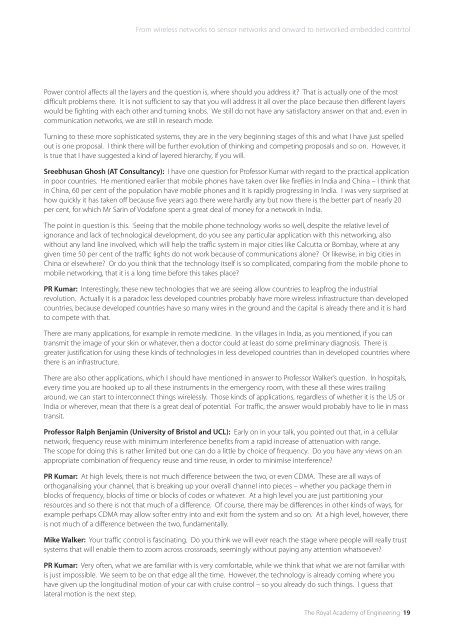Lecture Series in Mobile Telecommunications and Networks (1583KB)
Lecture Series in Mobile Telecommunications and Networks (1583KB)
Lecture Series in Mobile Telecommunications and Networks (1583KB)
Create successful ePaper yourself
Turn your PDF publications into a flip-book with our unique Google optimized e-Paper software.
From wireless networks to sensor networks <strong>and</strong> onward to networked embedded contrtol<br />
Power control affects all the layers <strong>and</strong> the question is, where should you address it? That is actually one of the most<br />
difficult problems there. It is not sufficient to say that you will address it all over the place because then different layers<br />
would be fight<strong>in</strong>g with each other <strong>and</strong> turn<strong>in</strong>g knobs. We still do not have any satisfactory answer on that <strong>and</strong>, even <strong>in</strong><br />
communication networks, we are still <strong>in</strong> research mode.<br />
Turn<strong>in</strong>g to these more sophisticated systems, they are <strong>in</strong> the very beg<strong>in</strong>n<strong>in</strong>g stages of this <strong>and</strong> what I have just spelled<br />
out is one proposal. I th<strong>in</strong>k there will be further evolution of th<strong>in</strong>k<strong>in</strong>g <strong>and</strong> compet<strong>in</strong>g proposals <strong>and</strong> so on. However, it<br />
is true that I have suggested a k<strong>in</strong>d of layered hierarchy, if you will.<br />
Sreebhusan Ghosh (AT Consultancy): I have one question for Professor Kumar with regard to the practical application<br />
<strong>in</strong> poor countries. He mentioned earlier that mobile phones have taken over like fireflies <strong>in</strong> India <strong>and</strong> Ch<strong>in</strong>a – I th<strong>in</strong>k that<br />
<strong>in</strong> Ch<strong>in</strong>a, 60 per cent of the population have mobile phones <strong>and</strong> it is rapidly progress<strong>in</strong>g <strong>in</strong> India. I was very surprised at<br />
how quickly it has taken off because five years ago there were hardly any but now there is the better part of nearly 20<br />
per cent, for which Mr Sar<strong>in</strong> of Vodafone spent a great deal of money for a network <strong>in</strong> India.<br />
The po<strong>in</strong>t <strong>in</strong> question is this. See<strong>in</strong>g that the mobile phone technology works so well, despite the relative level of<br />
ignorance <strong>and</strong> lack of technological development, do you see any particular application with this network<strong>in</strong>g, also<br />
without any l<strong>and</strong> l<strong>in</strong>e <strong>in</strong>volved, which will help the traffic system <strong>in</strong> major cities like Calcutta or Bombay, where at any<br />
given time 50 per cent of the traffic lights do not work because of communications alone? Or likewise, <strong>in</strong> big cities <strong>in</strong><br />
Ch<strong>in</strong>a or elsewhere? Or do you th<strong>in</strong>k that the technology itself is so complicated, compar<strong>in</strong>g from the mobile phone to<br />
mobile network<strong>in</strong>g, that it is a long time before this takes place?<br />
PR Kumar: Interest<strong>in</strong>gly, these new technologies that we are see<strong>in</strong>g allow countries to leapfrog the <strong>in</strong>dustrial<br />
revolution. Actually it is a paradox: less developed countries probably have more wireless <strong>in</strong>frastructure than developed<br />
countries, because developed countries have so many wires <strong>in</strong> the ground <strong>and</strong> the capital is already there <strong>and</strong> it is hard<br />
to compete with that.<br />
There are many applications, for example <strong>in</strong> remote medic<strong>in</strong>e. In the villages <strong>in</strong> India, as you mentioned, if you can<br />
transmit the image of your sk<strong>in</strong> or whatever, then a doctor could at least do some prelim<strong>in</strong>ary diagnosis. There is<br />
greater justification for us<strong>in</strong>g these k<strong>in</strong>ds of technologies <strong>in</strong> less developed countries than <strong>in</strong> developed countries where<br />
there is an <strong>in</strong>frastructure.<br />
There are also other applications, which I should have mentioned <strong>in</strong> answer to Professor Walker’s question. In hospitals,<br />
every time you are hooked up to all these <strong>in</strong>struments <strong>in</strong> the emergency room, with these all these wires trail<strong>in</strong>g<br />
around, we can start to <strong>in</strong>terconnect th<strong>in</strong>gs wirelessly. Those k<strong>in</strong>ds of applications, regardless of whether it is the US or<br />
India or wherever, mean that there is a great deal of potential. For traffic, the answer would probably have to lie <strong>in</strong> mass<br />
transit.<br />
Professor Ralph Benjam<strong>in</strong> (University of Bristol <strong>and</strong> UCL): Early on <strong>in</strong> your talk, you po<strong>in</strong>ted out that, <strong>in</strong> a cellular<br />
network, frequency reuse with m<strong>in</strong>imum <strong>in</strong>terference benefits from a rapid <strong>in</strong>crease of attenuation with range.<br />
The scope for do<strong>in</strong>g this is rather limited but one can do a little by choice of frequency. Do you have any views on an<br />
appropriate comb<strong>in</strong>ation of frequency reuse <strong>and</strong> time reuse, <strong>in</strong> order to m<strong>in</strong>imise <strong>in</strong>terference?<br />
PR Kumar: At high levels, there is not much difference between the two, or even CDMA. These are all ways of<br />
orthoganalis<strong>in</strong>g your channel, that is break<strong>in</strong>g up your overall channel <strong>in</strong>to pieces – whether you package them <strong>in</strong><br />
blocks of frequency, blocks of time or blocks of codes or whatever. At a high level you are just partition<strong>in</strong>g your<br />
resources <strong>and</strong> so there is not that much of a difference. Of course, there may be differences <strong>in</strong> other k<strong>in</strong>ds of ways, for<br />
example perhaps CDMA may allow softer entry <strong>in</strong>to <strong>and</strong> exit from the system <strong>and</strong> so on. At a high level, however, there<br />
is not much of a difference between the two, fundamentally.<br />
Mike Walker: Your traffic control is fasc<strong>in</strong>at<strong>in</strong>g. Do you th<strong>in</strong>k we will ever reach the stage where people will really trust<br />
systems that will enable them to zoom across crossroads, seem<strong>in</strong>gly without pay<strong>in</strong>g any attention whatsoever?<br />
PR Kumar: Very often, what we are familiar with is very comfortable, while we th<strong>in</strong>k that what we are not familiar with<br />
is just impossible. We seem to be on that edge all the time. However, the technology is already com<strong>in</strong>g where you<br />
have given up the longitud<strong>in</strong>al motion of your car with cruise control – so you already do such th<strong>in</strong>gs. I guess that<br />
lateral motion is the next step.<br />
The Royal Academy of Eng<strong>in</strong>eer<strong>in</strong>g 19

















